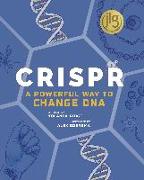- Start
- CRISPR
CRISPR
Angebote / Angebote:
First to market: few (or no) books on this topic exist for the children's market
Acsessible: CRISPR for Dummies. This book helps make the complex subject matter make sense. The goal of this book is to take the complex topic of CRISPR and distill it for high school readers, since almost every aspect of life may one day be affected by CRISPR technology.
All angles: the book delves into the mechanics as well as the moral questions the technology raises. In order to best explain the topic, the first two chapters go back to genetics 101 to give the reader an overview of the science. From there we have 7 chapters on how CRISPR affects health, disease prevention, food and the potential for its use on insects, animals and humans.
Each chapter ends with sections called "Go, Yield, Stop." These sections imagine the outcomes, and implications of using CRISPR. Example: bringing back Woolly Mammoth from extinction using preserved dna: GO: it would be so cool YIELD: how would a mammoth be socialized? Would it take resources from other endangered animals STOP: would CRISPR introduce new unpredictable medical issues, is there a reason to bring it back, would it cause suffering, could the animals survive on their own in the current environment?
Annotated Table of Contents:
Introduction
Chapter 1: Jumping Into Genetics
- The basics of genetics, including definitions for key terms like genome, DNA, inheritance, and chromosome, as well as the scientific connections between them.
Chapter 2: Rewriting the Genome
- How do we change and rearrange the genome? How did genetic engineering first begin, and what does it look like today? What is CRISPR, and how does it work?
Chapter 3: Better Blood
- This chapter explores the possibilities for CRISPR to eliminate single-gene mutations like sickle cell anemia. It establishes definitions for gene mutations and the difference between somatic and germline cells and provides examples of what might change in the future depending on how we use CRISPR to treat gene mutation.
Chapter 4: Mutant Mosquitoes
- What is a gene drive, and how can CRISPR be used to control the inheritance of certain traits? With the use of CRISPR, a malaria-resistance gene drive could be used to eliminate new cases of malaria within a year. But this kind of change has possible consequences. This chapter explores the differences between leaving mosquitoes as they are, introducing new gene drives, or eliminating mosquitoes altogether.
Chapter 5: Cancer Cured
- Unlike sickle cell anemia, cancer isn't a single-gene disorder. With some exceptions, mutations are acquired over a person's lifetime, not inherited. This chapter covers the possibilities for using CRISPR as part of immunotherapy, including using T-cells, targeting particular genes and developing drugs/treatment in direction response, and editing body cells to make them more receptive to treatment.
Chapter 6: Perfect Potatoes
- Our food supply is already heavily genetically modified, but CRISPR still stands to revolutionize what we eat. This chapter covers how CRISPR could be used to improve shelf life, protect crops, increase nutrition, and add flavour. It also covers the possible consequences of consuming GMOs.
Chapter 7: Healthy Herds
- Just as CRISPR can be used to change the plants and vegetables we consume, it can also be applied to the animals that we eat-to improve animal welfare, eliminate disease, and help farmers end up with more animals of the necessary sex (like female cows for producing dairy). But there are also other, safer ways to improve livestock, or even ways to avoid eating livestock altogether, like by "growing" meat instead.
Chapter 8: Death Defeated
- CRISPR has the potential to increase lifespan, prevent extinction, and even assist in creating cloned versions of already-extinct animals. But is the world ready for gene-edited animals? And what happens if a gene-edited animal becomes an invasive species?
Chapter 9: Enhanced Humans
- Of all of CRISPR's potential powers, this is often the most controversial. On one hand, it would be exciting to be able to improve ourselves, but on the other hand, who gets to decide what constitutes an "improvement"? What are the dangers of "playing God"? And does a desire to fix "broken" genes fall too closely onside with eugenics?
Chapter 10: Facing the Future
- This chapter moves through three imagined versions of the future: one where we moved full-steam ahead with CRISPR, one where we banned it and criminalized it, and one where we made an attempt at finding the middle road. As readers will see, each potential future is wildly different. There is so much potential to be found through the use of CRISPR technology, but there are significant risks as well. Regardless of the final outcomes, this technology is poised to affect many aspects of our lives, and the more informed we are about it, the better.
Backmatter
- Index
- Sources
- Further Reading and More Information
Lieferbar in ca. 10-20 Arbeitstagen

